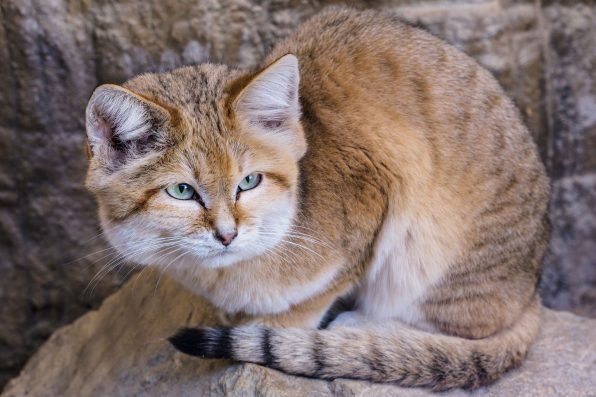In 2017, African sand cats captivated the internet after photos of them from a study conducted in Morocco went viral. Their miniature sizes and adorable faces make them look similar to a regular house cat, but these wild felines are well-adapted to the arid climates of the Sahara Desert and the Arabian Peninsula.
The sand cat weighs up to 7.5 pounds and has pale gray fur designed to help them camouflage themselves among the hard-packed gravel and dry brush of the harsh desert landscape. With their unique abilities to thrive in such desolate conditions, they are unlike any other wildcats known to science.
To understand more about the ecology of the species, a team of researchers has carried out the most extensive study of sand cats that has ever taken place. Their findings have helped break down the sand cat’s social dynamics and determine the sizes of their home range. They also discovered that the cat’s conservation status might need to be upgraded to “Near Threatened.”
Since the sand cats are so small and elusive, it was hard to track them through the extreme desert conditions. Still, the team did not back down from the challenge. They fitted 22 sand cats with VHF radio collars and followed them across southern Morocco, navigating through the glaring sun during the day, cold, strong winds at night, and uneven terrain.
As they observed the felines, they realized that the tiny sand cats were able to travel distances farther than previously thought, rivaling the ranges of larger cats, such as tigers and leopards. The sand cat’s projected range is about 1,093 square miles over six and a half months, although it is likely an underestimation. The cats can move beyond the area where technology can detect them, making it difficult to estimate where their ranges began and ended.
The vast desert may seem grim and empty, but further explorations showed there was more to the environment than meets the eye. The study’s lead author, Grégory Breton, described it as a place teeming with life.
“Our journey began in a scorching desert, with temperatures that can soar up to 50 degrees Celsius (122 degrees Fahrenheit) during the summer months. Local herders flock by with goats or camels, often accompanied by guard dogs. Though the flat, arid land may sometimes look bleak and barren, it is alive with incredible wildlife, including poisonous snakes, golden eagles, African golden wolves, and African wildcats,” said Breton.
The researchers managed to obtain strong data for 10 of the cats and were even able to track one male cat for over a year. The information they collected led them to believe that the cats lived a nomadic lifestyle, “which has never been reported for any wild cat.”
The travel patterns of the species seem to be based on ecological conditions. When their food sources of vegetation and rodents are scarce, or activities of humans and other animals disturb the area they’re occupying, sand cats will move to another location.

Sign up for Chip Chick’s newsletter and get stories like this delivered to your inbox.


